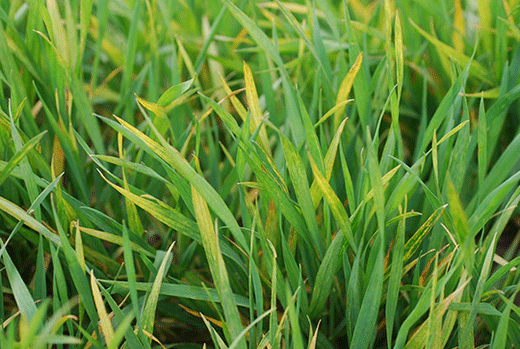
Yellowing in wheat fields could be a sign of disease, or it could be an indication of a deficiency in nitrogen or sulfur. (File photo, K-State Research and Extension)
Wheat growers urged to look for yellowing in fields
Off-color could signal nutrient deficiency, other issues
April 18, 2019
MANHATTAN, Kan. – A Kansas State University wheat expert says that yellowing in some Kansas wheat fields is not uncommon for this time of year, but growers should be aware of steps they should be taking if they are seeing the condition.
“The crop just went through winter and it hasn’t done much as far as growth,” said Romulo Lollato, a wheat production specialist with K-State Research and Extension. “But as the temperatures start warming up, it’s going to start growing, and with increased growth it has an increased need for nutrients.”
In those fields where nutrients – specifically nitrogen or sulfur – are lacking, some of the unusual yellowing may be occurring, Lollato said.
“This past winter, we had a lot of water-logged soils in Kansas that, depending on temperature conditions, can increase denitrification (or a loss of nitrogen),” he said. “And in soils that are more on the sandy side, we might actually lose nitrogen through leaching.”
He advised growers to keep close tabs on their crop to assure that it is not deficient in nitrogen, particularly as temperatures warm up. The latter part of April offers a critical window to correct for nitrogen deficiencies, though any nutrient management should be performed sooner rather than later, he said.
Lollato noted that yellowing in a wheat field could also be caused by a sulfur deficiency. Growers can identify the difference by looking at the plant’s leaves; if the crop is deficient in nitrogen, growers will see a pale yellow color in the older leaves, whereas if it is deficient in sulfur, the yellowing will show up in newer growth, and it may be more of a bright green color.
“Sulfur deficiency is going to become more common in Kansas fields because we are depositing less sulfur in the atmosphere” through other practices, Lollato said. “But luckily it is an easy fix.”
Typically, 20 pounds of sulfur per acre is enough to meet the demand of a crop yielding 80 bushels per acre. Many growers who apply liquid nitrogen include sulfur as part of the mix.
The important thing for growers needing to correct for nutrient deficiencies is that they do it right away, Lollato said.
K-State’s Department of Agronomy listed several other factors that could be causing yellowing in wheat fields in its most recent Agronomy eUpdate, published online at https://www.agronomy.k-state.edu.
Factors outlined include poor root growth due to drier soils or planting later in the fall; cold weather injury during tillering; freeze injury during jointing; or injury due to disease.
“This year one disease that seems to be more prevalent is soilborne mosaic virus, which is favored by cooler temps,” said Lollato, noting that weather conditions were conducive to the virus in northwest and central Kansas.
“In the field, it looks like yellow patches, but if you look a little closer at the leaves, it almost looks like green islands in a yellow background; it’s a mosaic.”
Growers are urged to contact their local extension agent with their questions. They may also contact Lollato at 785-532-0397, or follow K-State wheat specialists on Twitter or Facebook, @KSUWheat.

